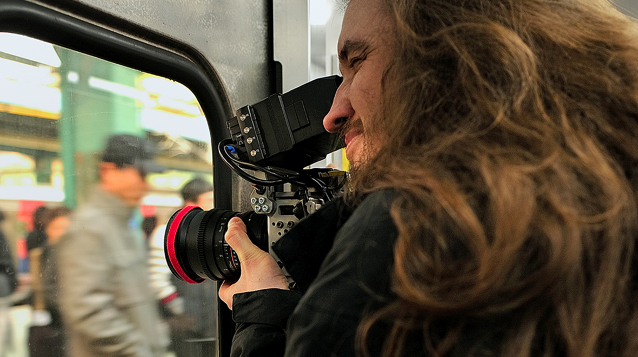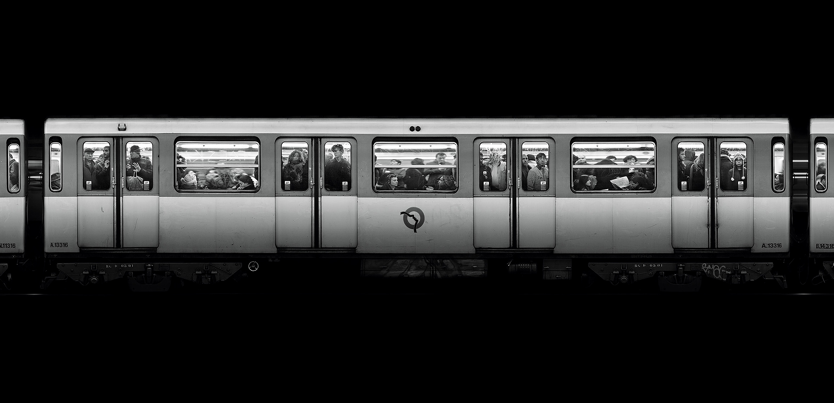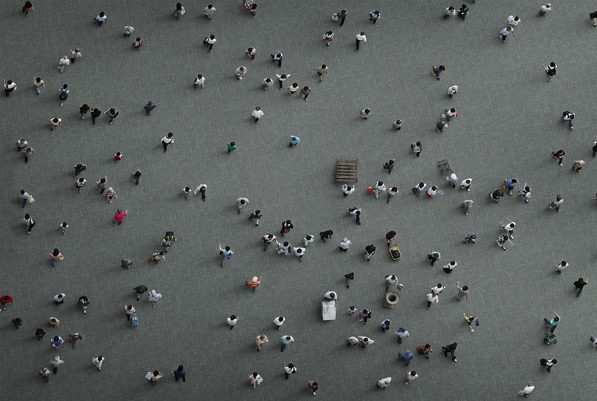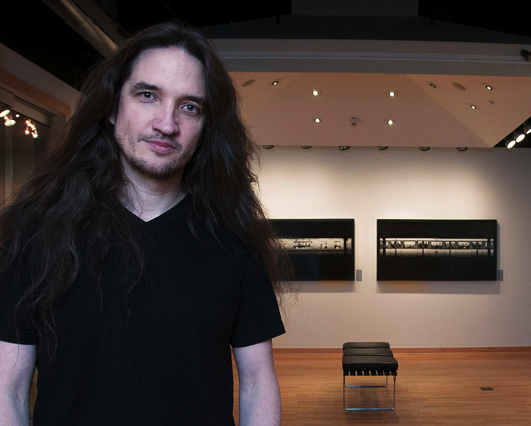ADAM MAGYAR
PEOPLEText: Victor Moreno
Existence and time are keywords in the stunning work of Adam Magyar, a sincere chap living between Berlin, Hungary, New York, Tokyo and Korea, dedicated to amplify the capacity of the human perception. He observes our society – human beings – and alters the concept of time, trying to set it from the most pure subjectivity, far away from any particular connotations –“they all are about nothingness,” he explains. In order to cope with it, he has built his own devices taken from industrial technology, machinery and spares. He also writes the code for the post-production software necessary to avoid former aesthetical issues once the footage is captured. First he started with stills, scanning people passing by a pedestrian crossing in the rush hour, creating a yet detailed surreal vision of such human flow. Then he crafted his technique on video constructing a new high-speed camera device. The outcome: he is able to unveil beautifulness from a single everyday life event. A series of photography stills and video in the underground of several capitals; a quite common event like the train arrival turns into a solitary approach to life, a stroll in an urban world of sculptural figures. Something that our eye or just conventional photography were not able to show us – a common event in our lives never seen it like it before.

photo by Jukerman A.Bahk
You are a self-taught photographer. Tell me a little bit about this start-off.
I was pretty organized taking photos when I was almost thirty. It happened because I was traveling and I was really non-talkative. I spent quite some time in India and most of the time I was alone around the Himalaya having some experiences so my choice to talk about it was taking photos.
Did you have former education at any photography school?
No, this is very interesting because I got a book during my elementary school years; it seems I did something good and I got this present for the end of the year like wow… I really didn’t open it but it was about photography, the technical basics, camera aperture and that sort of things. When I wanted to take photos I didn’t know anything about these things so I started to read that book, which it was about 20 years old, you know (laughs).
You have built your own devices both software and hardware.
Yeah.
I think you first built a camera out from the system of a scanner, in the same spirit of the photo-finish technique used in the Olympic games.
That’s the first thing I did. I was doing commercial or well let’s say usual way photography for quite a few years in dark rooms developing my own films and prints – I felt in love with black and white, even the videos I do now are in black and white – medium format and social photography because I was interested in people and human life, existence and time. I was not really satisfied with those and I wanted to do something else. When I was younger I was interested in programming and electronics but I never did anything with that, not even practicing for fifteen years, I guess. So when I was at this point with the photography I realized I wanted to do something through the technology and this experimentation delved into this first idea with the scanner. Then I started to do programming.
Was Urban Flow the first experiment you did with the scanner camera then?
Yeah.
So you carry on with your love for black and white.
I would like to keep certain things from the old school photography but I really like to use contemporary devices. Many cameras are contemporary but especially these devices that I use are contemporary in another way.
![]()
Stainless, Shinjuku
Then more recently you built the super-speed camera.
This is from a German factory. This industrial equipment is really amazing for certain things but they are not for photographers, they are not portable, you don’t have control of them, not in the same way as most photographers need, the quality is suitable for measuring. These devices are made for measuring not for aesthetics. So I always need to make implements in the quality, I made some software for postproduction to get rid of certain noise or quality issues in the light or the air, nothing important in the original purpose of this equipment due to it is for the factory or for science because they just would like to see when everything happens. That’s why this equipment is really fast and usually pretty sensitive so the quality they provide is not ready for photographers.

Stainless, A13316 (Paris)
Then I do understand what you have achieved is very unique; you have put a few things together that it is only you who has this machine.
Well, I think for the train photos, which is another industrial camera – a high-speed scanner camera – the factory uses it for scanning and a couple of artists has used the same technique but not really in the same way as I do. There are things similar in the market but it is hard to access, expensive or they are not user friendly, they are not flexible. To operate these cameras usually requires a computer or some other external equipment. I couldn’t do this if it doesn’t allow me to work on a pretty flexible way, [what I built] still not as flexible as a normal camera – it is a bit heavier and takes some time the system to start up, maybe it takes one minute to turn on the camera (he smiles) but still is pretty good compered to the original. This is the only piece of disclosure. (He smiles again).
But it keeps changing; I keep modifying and upgrading the system.
I presume it is a quite heavy back up for such footage.
Yes, it goes directly to my computer in my backpack. The camera needs to be controlled from the computer.
So you mean these cameras are intended for measuring and science projects in the first place?
They use these cameras for quality checking and I was using them for capturing humans. They high-speed ones, there are devices available for artists but I can’t afford them and usually no one can afford them so normally people when they need such cameras they rent it for a week. For a film production, when a team is working on something and everyone knows what’s going on and they have an exact plan it is possible to do things like that but for a solo visual artist like me, photographers, you need to work longer time on a project – you can’t be constrained in time because of a rental budget – so I am really happy I can use this camera for longer time because it allows me to experience, experiment for longer time, like the Berlin video, for instance, I needed time until find what it could work, that was the one when I did the first setting to be released.
Could you be so kind to tell us the steps you take on a project to make it happen?
I usually work a few weeks on a video studying how to accomplish it, location, and time of the day and keep shooting to get the result we see in the video. It depends on the project but with the work at the station I think I captured only two videos, it happened like that. Everything happens on a really short time, it is video! So you can’t guess otherwise it is not engaging anymore, it has to be filled, you need to have something all the time. So if there is one-second gap in these fifteen seconds recording, you’ll have one minute nothing on the video, so people will leave. I had to make sure there is always something that keeps people there that provides the attention, so I would like to show it keeps going with us all the time. So that made more difficult to find the spot where things happen on a certain way I like. And that goes too for the photos and even flows. They are images about streaming for two-three minutes, so in that interval things had to happen on a certain way.
How long does it take to do a project or video like this?
It depends. I’m usually not too productive. I usually don’t produce more than 5 videos or works within a year. Developments, the post-production and the pre-production making devices and preparing them for the project, and studying the location got to the place I like and analyze it. This usually takes a couple of months. I usually work for 2 years on a project and maybe I do ten pieces in 2-3 years.
Do you have any help to get all this together?
I do everything alone and well, I have my father on my side (laughs). I can send him drawings and he sends me the pieces I need within a few days. We have a very good father and son relationship. It is nice to keep things together, he likes helping in my projects.
![]()
Stainless, 42 Street
For me to understand Adam, for instance in “Stainless”, which is a series of videos shot in the underground of different capitals, are you shooting from inside the wagon?
Yeah, I am capturing from the train. I’m like a regular passenger standing in the door, with my camera behind the glass. It is just a normal arrival. That is what we miss every time. (He smiles).
So it is just real, nothing is staged? A good example is the girl running on the platform behind all the still figures.
No. That’s a gift.
Do you need to work with retouching as other conventional photography does?
Besides the normal adjustments, I always have some other quality problems very specific that for them I have to write some software solutions because are too especial problems in terms of noise, These noises are different from sensor to sensor or perhaps when I had to use the scanner camera and quite a frames has produced wavy images because the camera was slightly moving in my hand and I had to totally straight out the images…these kinds of things. No one else do this for me so I have to fix it by myself, writing specific software for an especial issue. I had to do quite a few of these machines.
I think you need a certain frequency of light for your equipment to work at the location.
The problem is that the light, I’m recording at high speed, and the normal flickering speed is less than my recording frequency, so the lights are bouncing. In the video “Stainless” you see the lights are bouncing in the background, which sometimes is really nice in these videos but for the photos it was really disturbing. Those images are recorded line by line; every line has a different exposure so I had under and over exposed lines so I had to do the adjustment in the shutter, there is no way to correct it at the location. In Tokyo I had to measure the light nearly on every station and I found some of the station had high frequency light.
![]()
Stainless, Sindorim
Then is when you readjust everything with the programming?
Yeah it is a lot of headache. It is not that I don’t like to do it, it is not entertaining and I am not a very good programmer, I am not very clever so it is time consuming to find solutions for these issues. You need to have patience. I have no other choice.
When I see your work, the first thing captivates me is the alteration and amplification of what the human is capable to perceive.
I’m happy to hear because I think it is pretty much like that. We all are living some sort of reality, which is obviously different to another reality from someone else, which is also true, and everything is so subjective. I just try to change the relationship to time and the changes that time creates in our life and how we look at things. We tend to look at our life in a really automatic way and we think it is really normal we are here, and I think is not normal but it is something really magical. So there are different interpretations of life and you can experience life in different ways but this normal day-to-day life obviously hides details and that.

Urban Flow, 323 (Hong Kong) / detail
I guess here is where you find all your inspiration and interest for the human being?
It’s like running on a track. That’s why I was doing Urban Flow, people are heading on the same way on a track, and everyone is flowing the same rule. And also that’s why the trains, because we are all in one train, in one cage or in one carrier, we are enclosed in one reality that we all share and besides that everything is dark, is in black, we don’t know what it is. We are on track again, that’s why those silver lines under the train, you always see a little bit of the track under the trains on my images. As a human being on a society we all have a reality. I’m not exactly interested in the human being but I wanted to do this to change the perception. The details and the quality in the photography are very magical. When you look at this videos or images you see that is real, it happens but still is very different than the way we see it in our usual life.
Your work is set up within the urban environment. Have you ever think of exploring any different set up?
Well, I do different sort of things but nothing really came out that was carrying that energy and I never show anything that doesn’t talk. My point is you need engaging situations, because if nothing happens for an interval these are wasted times. Instead, these situations are powerful life. No one thinks about it waiting for the train in a crowded subway station. We find it absolutely unnecessary. It is the same when we are walking on the streets from A to B. Even when I was doing conventional photography I was always into this. If I do something from unimportant moments, I can’t make the catch in the scene. It is funny, but maybe that was one of the main aspects that brought me to this. I am interested in time and life in general; I always try to avoid really particular connections on my images and try as much as possible to be as far away from anything that means anything than being away or holds some other connotations.
![]()
Urban Flow, 484 (Tokyo)
Do you mean it throughout all your work?
Yeah, they are all about nothingness. You see all these people [depicted in my work] have a story, you know that but you don’t see the stories. You rarely see any emotions because these people are always alone. Situations where we are alone in a public space and we are not communicating but we are trying to hide as much as possible. We are really condensed surrounded by many other people that you never met and you will probably never meet again, but you are still in loneliness. It is interesting because we are alone in our body and without personality. What ever you do whether is friends or family always at some point we are alone. We born alone and we will die alone. You are alone in your body. At the time these are situations everyone knows, we see them everyday, but I’m not capable of noticing this.
We could take the essence of this to the metaphoric level….
These intervals in our reality could be something we don’t want to see because we think there is nothing to see, but there are always things to see. There is always some beauty, because every moment is a gift. We tend to forget about that and we tend to notice it only when we are in trouble or we have too limited time left. Usually people start thinking about it when they get old or they are sick and realize that I’m actually too fragile. We all know we are going to die and we still are in denial. We don’t function as someone who can die, potentially. We always function as we will live forever or this week will last forever.
![]()
Stainless, Alexanderplatz
The series of zenithal still images “Squares” where we see people from above, are these taken in different shots?
Yeah, everyone was captured individually.
What kind of camera or equipment do you use for the still images?
I don’t really use conventional cameras on any of my portfolio work. However with “Squares” I did use a normal Canon. But besides that there is always something especial.

Squares, Hong Kong V
Your work has been exhibited at Julie Saul Gallery in New York. Please tell me about it.
I did a group exhibition under the name “Metro” but actually I will have my first solo exhibition there in February next year.
You’re been in Asia recently. I think both working and exhibiting your new work “Array.” Please tell me about it.
The Array I started to work on it in Seoul. It happened because this Seoul gallery organized my artistic residence program there so we shot it then. It is a two-channel installation, two videos projected in two walls. It was pretty nice.
It is very nice. How big was it?
It is a huge installation, about 5 meters by 2 and half meters projection, so you really are in this atmosphere. I was satisfied with that.
Would be great to hear what is in your mind at the moment, you just mentioned you will do a new solo exhibition in New York, for instance.
Yeah, this will be in February 2015. And I’m going to India soon. I was invited for the biggest TED x Gateway conference in Asia, which is going to be in Bombay in November. I’m going to speak there.

Will you show new work in your solo exhibition?
I don’t know yet, it is too early to talk about it. Maybe, because I have shot some new stuff. I captured a new video from Tokyo when I was there 2 weeks ago but it is not finished yet.
Text: Victor Moreno




